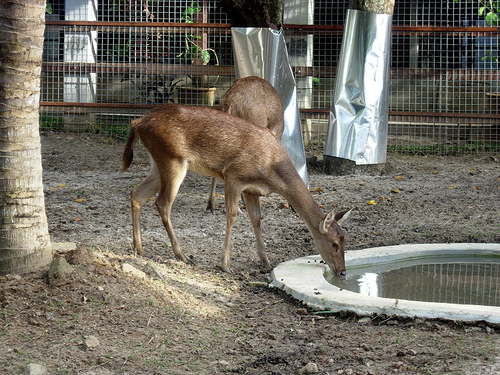|
Rusa Deer (Cervus timorensis) - Wiki
| 제목: | Rusa Deer (Cervus timorensis) - Wiki
| |

| 해상도: 500x375
파일크기: 174813 Bytes
등록시간: 2008:01:11 10:41:17
|
Rusa Deer
From Wikipedia, the free encyclopedia
Order: Artiodactyla
Family: Cervidae
Subfamily: Cervinae
[Photo] Rusa Deer, Cervus timorensis; Cervus (Rusa) timorensis. Author: Nut-meg (http://en.wikipedia.org/wiki/User:Nut-meg). URL: http://en.wikipedia.org/wiki/Image:Rusadeer.jpg
The Rusa Deer or Sunda Sambar, Cervus timorensis, are native to the islands of Java eastwards towards Bali, and Timor in Indonesia. This species of deer is similar in ecology to the Chital of India, occupying open dry and mixed deciduous forests, parklands, and savannas. Rusa deer are also found as an introduced species on the Australian mainland and are a close relative to the larger Sambar deer.
Rusa Deer are moderately hunted in Australasia and they have also established populations in remote islands probably brought by Indonesian fishermen. There are two subspecies of the Rusa deer; the more common and larger Javan Rusa, a large stag (male deer) weighing in at around 136 kg with does(females) being much smaller tipping the scales at around 96 kg. The second species of Rusa deer is the less common and slightly smaller Mollucan Rusa which on average are 20 kg lighter than their Javan cousins.
Rusa Deer are predominantly active around the early morning and late afternoon rarely being seen in the open and being very difficult to approach due to their keen senses and naturally cautious instincts. These deer have shown a very good sense of adaptation; living as comfortably in the dry Australian bush as they do in their tropical homelands. This trait is shown well in the more frequent encounters on the fringes of Wollongong and Sydney, and in particular, the Royal National Park, indicating steadily growing numbers and strong herds.
Rusa Deer are recognised by their large ears, the light tufts of hair above the eyebrows, the typical antlers seeming overly large for their body size. If you get get close to a free ranging Rusa stag and spook him, he will let out an extremely loud honk. This is a form of alarm and will alert any other deer in the vicinity of the unrecognised danger.
Rusa Deer are very sociable and you will rarely find one on its own; it may seem to be alone but these animals are masters of camouflage. Rusa Deer are so adept at hiding themselves that they may sometimes let you walk right past.
These animals breed around July and August in a period known as the rut. At this time stags battle for dominance and breeding rights of the females and contest these bouts through calling in a loud shrill bark or physical contact with the antlers.
The females calf at the start of spring and animals are mature in aroung 3 to 5 years depending on conditions and habitat.
http://en.wikipedia.org/wiki/Rusa_Deer
| The text in this page is based on the copyrighted Wikipedia article shown in above URL. It is used under the GNU Free Documentation License. You may redistribute it, verbatim or modified, providing that you comply with the terms of the GFDL. |
|
댓글 |
|---|
| | 손님 |
|
| Timor deer (Cervus timorensis) |
| | 손님 |
|
Scientific Name: Rusa timorensis (de Blainville, 1822)
Common Names:
English – Javan Deer, Sunda Sambar, Rusa, Rusa Deer, Javan Rusa, Timor Deer
French – Cerf de Timor
Spanish – Sambar de Java
Synonyms:
Cervus celebensis Rorig, 1896
Cervus hippelaphus G.Q. Cuvier, 1825
Cervus lepidus Sundevall, 1846
Cervus moluccensis Quoy & Gaimard, 1830
Cervus peronii Cuvier, 1825
Cervus russa Muller & Schlegel, 1845
Cervus tavistocki Lydekker, 1900
Cervus timorensis de Blainville, 1822
Cervus timorensis ssp. rusa Muller & Schlegel, 1845
Cervus tunjuc Horsfield, 1830 |
^o^
동물그림창고 똑똑전화 누리집
^o^
|
|
|